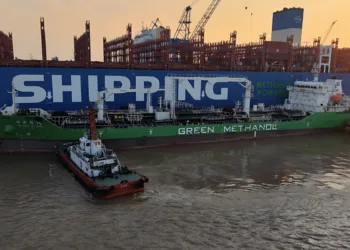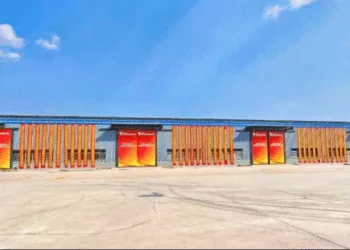Punit Oza discusses how the Lion Republic is repositioning itself to remain relevant as a maritime hub.
Singapore’s position as the world’s premier maritime hub has long been considered unassailable. The city-state’s strategic location at the confluence of major shipping lanes, its world-class infrastructure, and its reputation for efficiency have made it the gold standard for global maritime operations. Yet today, Singapore faces a confluence of geopolitical challenges that threaten to reshape its maritime dominance. The escalating trade war between the United States and China, coupled with shifting global trade patterns and rising regional competition, presents the most complex set of obstacles the Lion City has confronted in decades.
The trade war tsunami
The intensification of US-China trade tensions in 2025 has sent shockwaves through global shipping networks, and Singapore sits squarely in the eye of this storm. The imposition of reciprocal port fees between the two superpowers represents a fundamental shift in how maritime commerce operates. Washington’s decision to levy Section 301 fees on Chinese vessels, beginning at $50 per net ton, has been matched by Beijing’s countermeasures targeting American ships. This tit-for-tat escalation creates a treacherous operating environment for a neutral hub like Singapore that depends on serving vessels from all nations.
The broader tariff regime compounds these challenges. American tariffs on Chinese goods have reached unprecedented levels, with some analyses suggesting duties hit 145 percent on thousands of product categories before being revised downward to 30 percent as part of a tentative détente. Even at reduced rates, these tariffs represent a massive friction cost in global trade. Singapore’s economy, which thrives on the smooth flow of goods through its ports, faces direct consequences as trade volumes contract and shipping patterns become distorted.
The immediate impact is already visible in declining transshipment activity. When bilateral trade shrinks, fewer containers need to be moved, sorted, and redistributed through regional hubs. Singapore has built its maritime model around being the essential intermediary in Asia-Pacific supply chains, but protectionist measures undermine this entire value proposition. Every percentage point decline in regional trade volumes translates directly into reduced port throughput, lower ancillary service demand, and diminished revenues across Singapore’s extensive maritime ecosystem.
Rerouted trade flows and strategic realignment
Beyond the raw decline in volumes, trade wars are forcing a wholesale reconfiguration of global shipping routes. Companies seeking to avoid tariffs are restructuring their supply chains, often bypassing traditional trans-Pacific routes entirely. Some are nearshoring production to Mexico or other locations closer to American markets. Others are routing goods through alternative pathways to obscure country-of-origin designations, a practice that inherently reduces the need for major transshipment hubs.
China’s response to American trade pressure includes accelerating its Belt and Road Initiative and strengthening maritime links with alternative markets across Southeast Asia, Africa, and Europe. While this diversification could theoretically increase traffic through Singapore, it also presents risks. Beijing is investing heavily in competing port facilities throughout the region, from Malaysia’s Port Klang to Indonesia’s new deep-water facilities. The strategic calculus for Chinese state-owned shipping companies may increasingly favor ports in countries more politically aligned with Beijing, particularly as geopolitical tensions deepen.
The fragmentation of global trade into competing blocs represents an existential challenge to Singapore’s neutral hub model. The city-state has historically prospered by remaining open to all parties, offering a trusted intermediary space where goods from any origin could be efficiently processed and redistributed. But in an increasingly polarized world where economic relationships are subordinated to geopolitical positioning, neutrality itself becomes more difficult to maintain. Singapore must carefully navigate between its security alliance with the United States and its deep economic integration with China—a balancing act that grows more precarious as the two powers drift toward decoupling.
The Chinese port challenge
Perhaps the most formidable long-term threat comes from China’s systematic expansion of its own port infrastructure. Shanghai has already overtaken Singapore in container throughput volume, and Beijing continues investing billions in port automation, capacity expansion, and efficiency improvements across its coastal facilities. The development of deepwater ports capable of handling the largest container vessels means that some shipping lines can bypass Singapore entirely, sailing directly from Chinese manufacturing centers to destination markets.
China is also looking to make up the lost US volume by exporting more to Southeast Asia as well as Europe, looking more closely at the Northern Arctic Route for the latter destination. For the former destinations, the sailings may not involve calling Singapore at all.
Chinese ports also benefit from economies of scale that Singapore cannot match. They serve the world’s largest manufacturing base directly, eliminating the need for transshipment that is Singapore’s core business. As Chinese ports become more sophisticated and efficient, the value proposition for routing cargo through Singapore diminishes, particularly for goods whose origin or destination is China itself. The competitive pressure intensifies as Chinese state-owned enterprises, which control significant portions of global shipping capacity, face political incentives to favor domestic ports.
Singapore is not standing still in the face of this competition. The Tuas Port development represents one of the world’s most ambitious maritime infrastructure projects, designed to consolidate the city-state’s port operations into a single, highly automated mega-facility. When fully operational, Tuas will significantly expand capacity while reducing operating costs through advanced automation and artificial intelligence. Yet the fundamental challenge remains: Singapore is competing with a continental power that can leverage its vast domestic market and is willing to accept lower profit margins for strategic advantage.
Regional competition and strategic vulnerabilities
The competitive landscape extends beyond China. Malaysia, Indonesia, and other Southeast Asian nations are upgrading their port facilities with an eye toward capturing market share from Singapore. Modern container terminals in Port Klang, Tanjung Pelepas, and elsewhere offer lower costs and improving efficiency, making them increasingly viable alternatives for price-sensitive shippers. While Singapore maintains advantages in reliability, rule of law, and comprehensive maritime services, the gap is narrowing in core port operations.
The rise of regional competition intersects dangerously with political considerations. As ASEAN nations navigate between American and Chinese influence, their port development strategies increasingly reflect geopolitical alignments. Ports in countries that tilt toward Beijing may receive preferential treatment from Chinese shipping companies and manufacturers. Those aligned with Washington might benefit from supply chain diversification efforts by American firms. Singapore’s traditional neutrality, once a strength, risks becoming a liability if shippers and manufacturers feel compelled to choose sides.
Maritime security concerns add another dimension to Singapore’s challenges. Piracy incidents in Southeast Asian waters have increased significantly, with reported cases jumping from 21 in the first half of 2024 to 80 in the same period of 2025. While most incidents remain opportunistic rather than violent, the trend reflects broader instability in regional waters. Bulk carriers and tankers—critical to Singapore’s bunkering and petroleum hub status—have become primary targets. Any sustained increase in maritime insecurity could drive traffic toward alternative routes, undermining Singapore’s position.
Navigating uncertain waters
Singapore’s response to these challenges reveals both the city-state’s adaptability and the limits of what a small nation can achieve in an era of great power competition. Investment in cutting-edge port technology and automation represents a bet that operational excellence can offset geographic and scale disadvantages. Diversification of the maritime economy beyond pure port operations into ship financing, maritime insurance, and specialized services aims to create sticky relationships that transcend individual shipping decisions.
The city-state is also doubling down on its role as a maritime knowledge hub, hosting industry conferences, maintaining robust legal and arbitration services, and positioning itself as the regional center for maritime innovation. These efforts seek to entrench Singapore’s position through network effects and specialized expertise that cannot be easily replicated. Yet such strategies take time to pay dividends, and the immediate pressures from trade disruption and shifting volumes demand more urgent responses.
Perhaps most critically, Singapore must navigate the political dimensions of its maritime future. Maintaining relationships with both American and Chinese interests requires diplomatic dexterity, particularly as both powers increasingly view economic relationships through a security lens. The city-state cannot afford to alienate either power, yet avoiding entanglement in their rivalry grows more difficult as the competition intensifies. Every policy decision—from port access rules to shipping regulations to technology partnerships—carries geopolitical implications that extend far beyond maritime operations.
Singapore’s maritime hub faces challenges that are simultaneously economic and geopolitical, immediate and structural. The trade war between the United States and China creates direct pressure through reduced volumes and distorted trade flows. Chinese port expansion threatens Singapore’s fundamental business model. Regional competition intensifies across Southeast Asia. Maritime security concerns add operational risks. The fragmentation of the global trading system into competing blocs undermines the neutral hub model that has underwritten Singapore’s success.
Yet Singapore has overcome existential challenges before through strategic vision, adaptability, and relentless focus on operational excellence. The city-state’s response—massive infrastructure investment, technological leadership, economic diversification, and careful diplomatic balancing—reflects a clear understanding of the stakes. Whether these measures prove sufficient depends not only on Singapore’s choices but on forces largely beyond its control: the trajectory of US-China relations, the resilience of global trade integration, and the willingness of the international community to preserve neutral spaces in an increasingly polarized world. The coming years will determine whether Singapore can sustain its maritime preeminence or whether it becomes another casualty of great power competition.





















